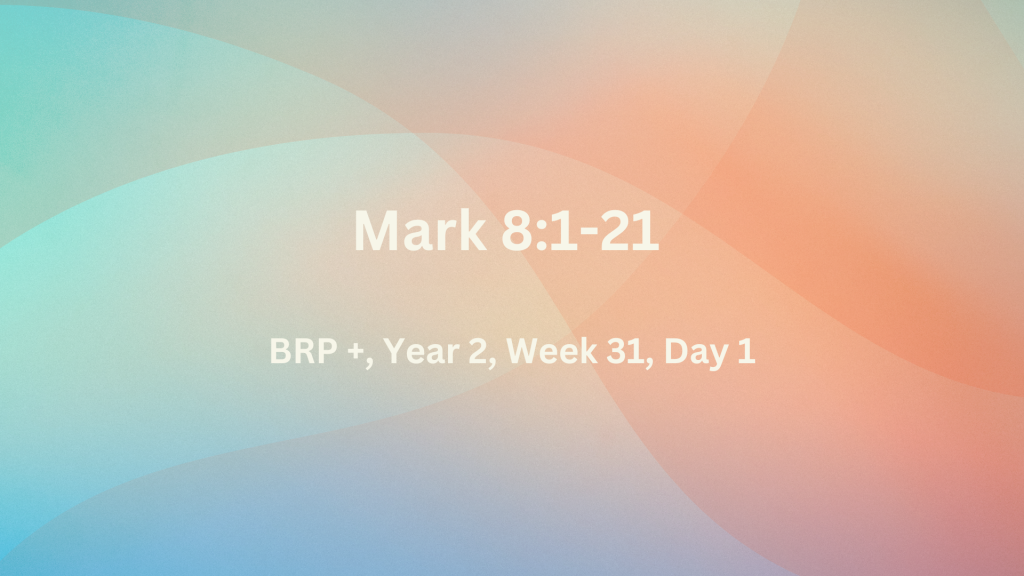Mark 8:1-21
Q .1. Why did Jesus tell His disciples He wanted to feed the crowds? What makes their response disappointing? How did Jesus involve them? How did the miracle end? – (Mk.8:1-9)
Jesus was on a mission to save the world. However, who would know about His salvation, without followers to pass on the Gospel? Jesus again wanted His disciples to grow in faith, so told them – 2 I feel compassion for the people because they have remained with Me now three days and have nothing to eat. 3 If I send them away hungry to their homes, they will faint on the way; and some of them have come from a great distance (Mk.8:2-3). Jesus must have been disappointed that they only considered their own resources (Mk.8:4). They had just seven loaves. Jesus went through the same process as before, beginning with thanks, then breaking the bread to be distributed by His disciples (Mk.8:5-6 c.f. Mk.6:41). He did the same with a few small fish, which He blessed, before they too were shared with all the people. (Mk.8:7). Mark reported – And they ate and were satisfied, and they picked up seven large baskets full of what was left over of the broken pieces (Mk.8:8 c.f. Mk.6:42-43).
Q.2. What did the Pharisees ask Jesus? Why did He refuse to give them a sign? How do we account for the difference in Matthew’s recollection? – (Mk.8:10-13 c.f. Mt.12:38-42)
After all the marvellous miracles that Jesus had done, – The Pharisees came out and began to argue with Him, seeking from Him a sign from heaven, to test Him (Mk.8:11). John, in his Gospel, chose a series of miracles that he called signs, pointing to His Messiahship (c.f. Jn.2:11, 23; 3:2; 4:54; 6:14, 26; 9:16; 11:47; 20:30; 21:25 etc). In other words, Jesus had already performed many miracles, and refused to give a special display of His powers (Mk.8:12). Mark, writing to Gentiles unfamiliar with the Scriptures, did not include Matthew’s account – An evil and adulterous generation craves for a sign; and yet no sign will be given to it but the sign of Jonah the prophet; for just as Jonah was three days and three nights in the belly of the sea monster, so will the Son of Man be three days and three nights in the heart of the earth (Mt.12:39-40 c.f. Jonah 1:17). The Romans would have read enough in Mark’s Gospel, to know that to ask Jesus for further signs was ridiculous.
Q.3. Where did Jesus go? Why did Jesus discuss about leaven? How did the disciples understand His comment? What point was Jesus driving home to them? – (Mk.8:13-21)
After this clash with the Pharisees, Jesus and His disciples sailed from Dalmanutha on the west of the Sea of Galilee, north toward Bethsaida (Mk.8:10 & 22). Mark recorded that the disciples had forgotten to take bread, despite the seven large baskets of leftovers (Mk.8:14 c.f. Mk.8:8). Jesus wanted His disciples to learn from the incident back on shore. He spoke strongly, warning them – Watch out! Beware of the leaven of the Pharisees and the leaven of Herod (Mk.8:15 c.f. Mk.8:11; 12:13; Lk.13:31-32). The disciples thought that Jesus was hinting about their failure to bring food (Mk.8:16). Jesus broke into their discussion and said -… Why do you discuss the fact that you have no bread? Do you not yet see or understand? Do you have a hardened heart? (Mk.8:17). He reminded them about the feeding of the five thousand and then later, the four thousand. He asked them how many baskets of food remained, and they replied – Twelve … and Seven (Mk.8:19-20). And He was saying to them, “Do you not yet understand?” (Mk.8:21). He wanted them (and us) to know that resources will never be a problem when Jesus is in it. The One Who fed the multitudes and the sparrows (c.f. Matthew 10:29-31) would surely feed them, so their worries were unwarranted, and showed lack of faith.

